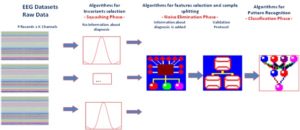I FAST Implicit Function As Squashing Time (International patent)
This method is able to transform a temporal multivariate sequence of data in a fixed set of parameters. Real applications of this algorithm are wide: for example,the capability to extract useful information from a rough EEG track, using only mathematical algorithms, is a challenging task.
Let us consider a multivariate sequence of signals generated by the same source. This sequence works in a temporal a-synchronism and in parallel at the same time. The dynamics of each signal, in fact, depends simultaneously from the dynamics of the others signals and from its dynamics in a precedent time. At the same time, the dynamics of each signal will act on the dynamics of the others (itself included) in the after time. That because the whole dynamics is a complex dialog among the different areas of the brain along the time. Consequently, every multivariate sequence of signals is a complex dynamical system, whose features are highly non linear in space and in time. So, the dynamics of each channel in EEG has to be processed only in relation to the others.
The implicit function of a multivariate sequence of signals transforms this temporal process into an spatial hyper-surface. The interaction among the 19 channels along the time is squashed into a complex and highly non linear space, whose parameters define the Meta-Model of the relationship among all the channels.
The structure of I-FAST is composed of different phases :
- The transformation of the 19 EEG channels of each subject into a vector of features (Squashing Phase);
- The dynamic elimination of the noisy features from the vector representing each subject (Noise Elimination Phase);
- The intelligent classification, with the support of Machines Learning, of the features of each subject (Classification Phase).

Patents:
Implicit Function As Squashing Time Method of processing multichannel and multivariate signals and method of classifying sources of multichannel and multivariate signals operating according to such processing method Applicant Semeion Research Centre Inventor M. Buscema , International Patent: Application n. PCT/EP2007/055646 deposited 06-08-2007, European Patent: Application n. 06115223.7 deposited 06-09-2006.
References:
Massimo Buscema, Paolo Rossini, Claudio Babiloni, Enzo Grossi,The IFAST model, a novel parallel nonlinear EEG analysis technique, distinguishes mild cognitive impairment and Alzheimer’s disease patients with high degree of accuracy, Artificial Intelligence in Medicine (2007) 40, 127—141.
Massimo Buscema,Massimiliano Capriotti,Francesca Bergami, Claudio Babiloni,Paolo Rossini,and Enzo Grossi, The Implicit Function as Squashing TimeModel: A Novel Parallel Nonlinear EEG Analysis Technique Distinguishing Mild Cognitive Impairment and Alzheimer’s Disease Subjects with High Degree of Accuracy,Hindawi Publishing Corporation Computational Intelligence and Neuroscience, Volume 2007, Article ID 35021, 15 pages, doi:10.1155/2007/35021.
Paolo M. Rossini, Massimo Buscema, Massimiliano Capriotti, Enzo Grossi,Guido Rodriguez, Claudio Del Percio, Claudio Babiloni, Is it possible to automatically distinguish resting EEG data of normal elderly vs. mild cognitive impairment subjects with high degree of accuracy?, Clinical Neurophysiology 119 (2008) 1534–1545.
M Buscema, E Grossi, M Capriotti, C Babiloni, PM Rossini, 2010, The I.F.A.S.T. Model Allows the Prediction of Conversion to Alzheimer Disease in Patients with Mild Cognitive Impairment with High Degree of Accuracy, Current Alzheimer Research, 2010, 7, 173-187.
